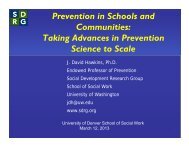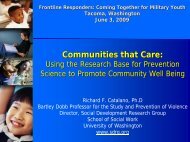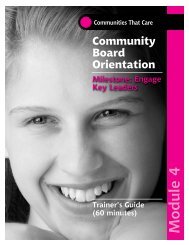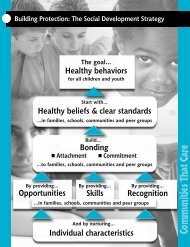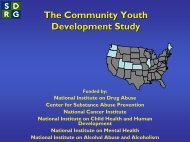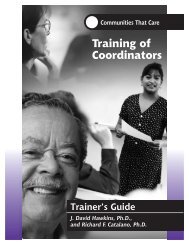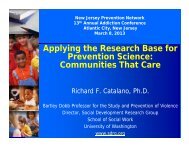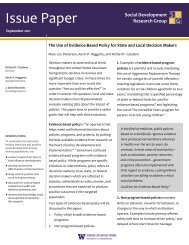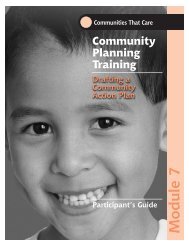What is the Evidence Base for Prevention in Adolescence?
What is the Evidence Base for Prevention in Adolescence?
What is the Evidence Base for Prevention in Adolescence?
Create successful ePaper yourself
Turn your PDF publications into a flip-book with our unique Google optimized e-Paper software.
Murdoch Children’s Research Institute<br />
February 24, 2012<br />
<strong>What</strong> <strong>is</strong> <strong>the</strong> <strong>Evidence</strong> <strong>Base</strong> <strong>for</strong><br />
<strong>Prevention</strong> <strong>in</strong> <strong>Adolescence</strong>?<br />
Richard F. Catalano, Ph.D.<br />
Bartley Dobb Professor <strong>for</strong> <strong>the</strong> Study and <strong>Prevention</strong> of Violence<br />
Director, Social Development Research Group<br />
School of Social Work<br />
University of Wash<strong>in</strong>gton<br />
sdrg.org<br />
and <strong>the</strong> author group <strong>for</strong> <strong>the</strong> <strong>Prevention</strong> article <strong>in</strong> Lancet series<br />
on Adolescent Health: Abigail Fagan, Loretta E. Gav<strong>in</strong>, Mark T.<br />
Greenberg, Charles Irw<strong>in</strong>, David A. Ross, Daniel T.L. Shek
Intervention Spectrum<br />
Treatment<br />
Source: Institute of Medic<strong>in</strong>e (2009). Prevent<strong>in</strong>g Mental, Emotional and<br />
Behavioral D<strong>is</strong>orders Among Young People. O’Connell, Boat & Warner<br />
(eds.) Wash<strong>in</strong>gton DC: National Academy Press
<strong>Prevention</strong> Science<br />
Framework<br />
Program<br />
Implementation<br />
and<br />
Evaluation<br />
Def<strong>in</strong>e <strong>the</strong><br />
Problem<br />
Identify R<strong>is</strong>k<br />
and Protective<br />
Factors<br />
Interventions<br />
Problem<br />
Response
<strong>Prevention</strong> Science<br />
Research Advances<br />
Etiology/Epidemiology of Problem Behaviors<br />
• Identify r<strong>is</strong>k and protective factors that<br />
predict problem behaviors and describe<br />
<strong>the</strong>ir d<strong>is</strong>tribution <strong>in</strong> populations.<br />
Efficacy Trials<br />
• Design and test preventive <strong>in</strong>terventions<br />
to <strong>in</strong>terrupt causal processes that lead to<br />
youth problems.<br />
<strong>Prevention</strong> Services Research<br />
• Apply lessons learned about etiology and<br />
effective <strong>in</strong>terventions <strong>in</strong> real world<br />
sett<strong>in</strong>gs.
R<strong>is</strong>k Factors <strong>for</strong><br />
Adolescent Problem Behaviors<br />
R<strong>is</strong>k Factors<br />
Substance Abuse<br />
Del<strong>in</strong>quency<br />
Teen Pregnancy<br />
School Drop-Out<br />
Violence<br />
Depression &<br />
Anxiety<br />
Community<br />
Availability of Drugs<br />
<br />
<br />
Availability of Firearms<br />
<br />
<br />
Community Laws and Norms Favorable<br />
Toward Drug Use, Firearms, and Crime<br />
<br />
<br />
<br />
Media Portrayals<br />
<br />
<br />
Transitions and Mobility<br />
<br />
<br />
<br />
<br />
Low Neighborhood Attachment and<br />
Community D<strong>is</strong>organization<br />
<br />
<br />
<br />
Extreme Economic Deprivation
R<strong>is</strong>k Factors <strong>for</strong><br />
Adolescent Problem Behaviors<br />
R<strong>is</strong>k Factors<br />
Substance Abuse<br />
Del<strong>in</strong>quency<br />
Teen Pregnancy<br />
School Drop-Out<br />
Violence<br />
Depression & Anxiety<br />
Family<br />
Family H<strong>is</strong>tory of <strong>the</strong> Problem Behavior<br />
<br />
<br />
<br />
<br />
<br />
<br />
Family Management Problems<br />
<br />
<br />
<br />
<br />
<br />
<br />
Family Conflict<br />
<br />
<br />
<br />
<br />
<br />
<br />
Favorable Parental Attitudes and Involvement <strong>in</strong><br />
<strong>the</strong> Problem Behavior
R<strong>is</strong>k Factors <strong>for</strong><br />
Adolescent Problem Behaviors<br />
Depression & Anxiety<br />
Violence<br />
School Drop-Out<br />
Teen Pregnancy<br />
Del<strong>in</strong>quency<br />
Substance Abuse<br />
R<strong>is</strong>k Factors<br />
School<br />
<br />
<br />
<br />
<br />
<br />
<br />
Academic Failure Beg<strong>in</strong>n<strong>in</strong>g <strong>in</strong> Late Elementary<br />
School<br />
Lack of Commitment to School
R<strong>is</strong>k Factors <strong>for</strong><br />
Adolescent Problem Behaviors<br />
R<strong>is</strong>k Factors<br />
Substance Abuse<br />
Del<strong>in</strong>quency<br />
Teen Pregnancy<br />
School Drop-Out<br />
Violence<br />
Depression & Anxiety<br />
Individual/Peer<br />
Early and Pers<strong>is</strong>tent Ant<strong>is</strong>ocial Behavior<br />
<br />
<br />
<br />
<br />
<br />
<br />
Rebelliousness<br />
<br />
<br />
<br />
Friends Who Engage <strong>in</strong> <strong>the</strong> Problem Behavior<br />
<br />
<br />
<br />
<br />
<br />
Favorable Attitudes Toward <strong>the</strong> Problem<br />
Behavior<br />
<br />
<br />
<br />
<br />
Early Initiation of <strong>the</strong> Problem Behavior<br />
<br />
<br />
<br />
<br />
<br />
Constitutional Factors
Protective Factors<br />
Individual Character<strong>is</strong>tics<br />
– High Intelligence<br />
– Resilient Temperament<br />
– Competencies and Skills<br />
In each social doma<strong>in</strong> (family, school, peer<br />
group and neighborhood)<br />
– Prosocial Opportunities<br />
– Re<strong>in</strong><strong>for</strong>cement <strong>for</strong> Prosocial Involvement<br />
–Bond<strong>in</strong>g<br />
– Healthy Beliefs and Clear Standards
R<strong>is</strong>k and Protective Factors<br />
Shap<strong>in</strong>g Child and<br />
Adolescent Development<br />
Community<br />
Peers<br />
School<br />
Parents<br />
1 2 3 4 5 6 7 8 9 10 11 12 13 14 15 16 17 18 19
R<strong>is</strong>k Snowstorm: and Protective Extended Exposure Factors<br />
Snowball: R<strong>is</strong>k Accumulates<br />
Positive Substance Use Norms and<br />
Models of Problem Behavior without<br />
Protection<br />
Shap<strong>in</strong>g Child and<br />
through Early Developmental<br />
Adolescent Development<br />
Challenges without Protection<br />
Community<br />
Peers<br />
School<br />
Parents<br />
Toumbourou and Catalano, 2005<br />
1 2 3 4 5 6 7 8 9 10 11 12 13 14 15 16 17 18 19
Prevalence of 30 Day Alcohol Use<br />
by Number of R<strong>is</strong>k and Protective Factors<br />
Six State Student Survey of 6th-12th Graders, Public School<br />
Students<br />
100%<br />
Prevalence<br />
90%<br />
80%<br />
70%<br />
60%<br />
50%<br />
40%<br />
30%<br />
20%<br />
10%<br />
Number of<br />
Protective Factors<br />
0 to 1<br />
2 to 3<br />
4 to 5<br />
6 to 7<br />
8 to 9<br />
0%<br />
0 to 1 2 to 3 4 to 5 6 to 7 8 to 9 10+<br />
Number of R<strong>is</strong>k Factors
Prevalence of Any O<strong>the</strong>r Illicit Drug Use<br />
(Past 30 Days)<br />
By Number of R<strong>is</strong>k and Protective Factors<br />
100%<br />
Six State Student Survey of 6th - 12th Graders,<br />
Public School Students<br />
90%<br />
Prevalence<br />
80%<br />
70%<br />
60%<br />
50%<br />
40%<br />
30%<br />
Number of<br />
Protective<br />
Factors<br />
0 to 1<br />
2 to 3<br />
4 to 5<br />
6 to 8<br />
20%<br />
10%<br />
0%<br />
0 to 1 2 to 3 4 to 5 6 to 8 9 or More<br />
Number of R<strong>is</strong>k Factors
Prevalence of “Attacked to Hurt”<br />
By Number of R<strong>is</strong>k and Protective Factors<br />
60%<br />
50%<br />
Prevalence<br />
40%<br />
30%<br />
20%<br />
Protection, Level 0<br />
Protection, Level 1<br />
Protection, Level 2<br />
Protection, Level 3<br />
Protection, Level 4<br />
10%<br />
0%<br />
R<strong>is</strong>k, Level<br />
0<br />
R<strong>is</strong>k, Level<br />
1<br />
R<strong>is</strong>k, Level<br />
2<br />
R<strong>is</strong>k, Level<br />
3<br />
R<strong>is</strong>k, Level<br />
4
Prevalence of Mental and Social Problems<br />
by Number of R<strong>is</strong>k Factors<br />
50<br />
40<br />
%<br />
30<br />
20<br />
10<br />
depressive<br />
symptomatology<br />
deliberate self harm<br />
homelessness<br />
early sexual activity<br />
0<br />
0-1 2-3 4-6 7-9 >=10<br />
R<strong>is</strong>k factors<br />
Bond, Thomas, Toumbourou, Patton,<br />
and Catalano, 2000
Number of School Build<strong>in</strong>g R<strong>is</strong>k<br />
Factors and Probability of Meet<strong>in</strong>g<br />
WASL Standard (10 th Grade Students)<br />
Probability of Meet<strong>in</strong>g Standard<br />
1.0<br />
0.9<br />
0.8<br />
0.7<br />
0.6<br />
0.5<br />
0.4<br />
0.3<br />
0.2<br />
0.1<br />
0.0<br />
0 1 2 3 4 5 6 7 8 9 10 11 12 13 14 15 16<br />
Number of R<strong>is</strong>k Factors<br />
Math Read<strong>in</strong>g Writ<strong>in</strong>g<br />
Arthur and Brown, 2006
Number of School Build<strong>in</strong>g Protective<br />
Factors and Probability of Meet<strong>in</strong>g<br />
WASL Standard (10 th grade students)<br />
Probability of Meet<strong>in</strong>g Standard<br />
1.0<br />
0.9<br />
0.8<br />
0.7<br />
0.6<br />
0.5<br />
0.4<br />
0.3<br />
0.2<br />
0.1<br />
0.0<br />
0 1 2 3 4 5 6 7<br />
Number of Protective Factors<br />
Math Read<strong>in</strong>g Writ<strong>in</strong>g<br />
Arthur and Brown, 2006
Why a Place <strong>Base</strong>d Approach?<br />
Communities Vary <strong>in</strong> R<strong>is</strong>k Exposure<br />
Neighborh ood #2<br />
In su f fic ie nt n um b e r of<br />
st u de n ts <strong>in</strong> th <strong>is</strong> are a.<br />
No s tu den ts<br />
<strong>in</strong> t h<strong>is</strong> a re a .<br />
Neighborhood #1 Neighborh oo d #3<br />
John A. Pollard , P h.D. Developmental Research and Pr ograms
<strong>Prevention</strong> Science<br />
Research Advances<br />
Etiology/Epidemiology of Problem Behaviors<br />
• Identify r<strong>is</strong>k and protective factors that<br />
predict problem behaviors and describe<br />
<strong>the</strong>ir d<strong>is</strong>tribution <strong>in</strong> populations.<br />
Efficacy Trials<br />
• Design and test preventive <strong>in</strong>terventions<br />
to <strong>in</strong>terrupt causal processes that lead<br />
to youth problems.<br />
<strong>Prevention</strong> Services Research<br />
• Apply lessons learned about etiology<br />
and effective <strong>in</strong>terventions <strong>in</strong> real world<br />
sett<strong>in</strong>gs
Effectiveness of <strong>Prevention</strong><br />
Policies and Programs<br />
Reviewed <strong>in</strong> 7 Areas<br />
Violence<br />
Substance M<strong>is</strong>use (exclud<strong>in</strong>g Tobacco)<br />
HIV/STI<br />
Un<strong>in</strong>tended Pregnancy<br />
Traffic Crashes and R<strong>is</strong>ky Driv<strong>in</strong>g<br />
Obesity<br />
Mental Health
<strong>What</strong> <strong>is</strong> an efficacious <strong>in</strong>tervention?<br />
Evaluation Quality<br />
• At least one randomized<br />
controlled trial OR a quasiexperimental<br />
trial without design<br />
flaws<br />
Impact<br />
• Impact on adolescent problem<br />
behavior<br />
• Absence of any negative effects<br />
Intervention Specificity<br />
• Population of focus <strong>is</strong> clearly<br />
def<strong>in</strong>ed<br />
• R<strong>is</strong>k and protective factors that<br />
program seeks to change are<br />
identifiable<br />
Implementation Tools<br />
• Tra<strong>in</strong><strong>in</strong>g materials are available<br />
• In<strong>for</strong>mation on <strong>the</strong> f<strong>in</strong>ancial and<br />
human resources required
<strong>Prevention</strong> Policy Example<br />
Ra<strong>is</strong><strong>in</strong>g <strong>the</strong> M<strong>in</strong>imum<br />
Legal Dr<strong>in</strong>k<strong>in</strong>g Age<br />
Ra<strong>is</strong>e M<strong>in</strong>.<br />
Legal<br />
Dr<strong>in</strong>k<strong>in</strong>g Age<br />
Reduced Alcohol<br />
Consumption,<br />
Reduced Crashes<br />
Crash Injury, and<br />
Fatalities<br />
Traffic Crashess<br />
R<strong>is</strong>ky Alcohol<br />
Use<br />
Dr<strong>in</strong>k Driv<strong>in</strong>g<br />
Problem<br />
Wagenaar and Toomey, 2002<br />
Response
Poor Birth<br />
And Early<br />
Childhood<br />
Outcomes<br />
<strong>Prevention</strong> Program Example<br />
Nurse Family<br />
Partnership<br />
R<strong>is</strong>k: Poor Diet<br />
And Drug Use<br />
Prot.: Parent<strong>in</strong>g<br />
Competence<br />
And Bond<strong>in</strong>g<br />
Protocol <strong>for</strong><br />
Nurse V<strong>is</strong>its<br />
Dur<strong>in</strong>g<br />
Pregnancy And<br />
2 yrs. Post Birth<br />
Mom: Less welfare<br />
More employment,<br />
Fewer Arrests and<br />
Subsequent Births,<br />
Wide Rang<strong>in</strong>g Approaches Have Been<br />
Found To Be Efficacious<br />
<strong>Prevention</strong> Programs/Policies<br />
1. Prenatal & Infancy Programs(eg., NFP)<br />
2. Early Childhood Education<br />
3. Parent Tra<strong>in</strong><strong>in</strong>g<br />
4. After-school Recreation<br />
5. Mentor<strong>in</strong>g with Cont<strong>in</strong>gent<br />
Re<strong>in</strong><strong>for</strong>cement<br />
6. Cognitive Behavior Therapy<br />
7. Classroom Organization, Management<br />
and Instructional Strategies<br />
8. Classroom Curricula<br />
Violence<br />
<br />
<br />
<br />
Drug Use<br />
<br />
<br />
<br />
<br />
HIV STI<br />
Un<strong>in</strong>tended Pregnancy<br />
<br />
Vehicle Crash R<strong>is</strong>k<br />
Obesity<br />
<br />
<br />
<br />
<br />
Mental Health
Wide Rang<strong>in</strong>g Approaches Have Been<br />
Found To Be Efficacious<br />
<strong>Prevention</strong> Programs/Policies<br />
9. Community <strong>Base</strong>d Skills Tra<strong>in</strong><strong>in</strong>g/Motivational<br />
Interview<strong>in</strong>g<br />
10. Cash Transfer <strong>for</strong> School Fees/Stipend<br />
11. Multicomponent Positive Youth Development<br />
12. Policies (eg., MLDA)<br />
13. Community Mobilization<br />
14. Medical Intervention<br />
15. Law En<strong>for</strong>cement<br />
16. Family Plann<strong>in</strong>g Cl<strong>in</strong>ic<br />
Violence<br />
<br />
<br />
Drug Use<br />
<br />
<br />
HIV STI<br />
<br />
<br />
Un<strong>in</strong>tended Pregnancy<br />
<br />
<br />
<br />
<br />
<br />
Vehicle Crashes<br />
<br />
<br />
Obesity<br />
Mental Health
Criteria <strong>for</strong> Selection of<br />
Illustrative Programs<br />
• Randomized or quasi-experimental designs<br />
• Stat<strong>is</strong>tically significant effect on problem<br />
behaviors dur<strong>in</strong>g adolescence at least one<br />
year post <strong>in</strong>tervention<br />
• Operate dur<strong>in</strong>g childhood or adolescence<br />
• Examples address both snowball and<br />
snowstorm r<strong>is</strong>k patterns<br />
• Some diversity <strong>in</strong> global context
Illustrative Efficacious <strong>Prevention</strong><br />
Policies<br />
Age 12-18<br />
• Adolescent Access to Contraceptives (Br<strong>in</strong>d<strong>is</strong><br />
et al., 2003; Foster et al., 2006; Boonstra et al., 2010; Guldi, 2008;<br />
Zavodny, 2004; Kearney & Lev<strong>in</strong>e, 2009)<br />
• Graduated Driver Licens<strong>in</strong>g (Shope, 2007)<br />
• Increased Taxes on Alcohol (Wagenaar et al., 2009;<br />
Elder et al., 2010)<br />
• M<strong>in</strong>imum Legal Dr<strong>in</strong>k<strong>in</strong>g Age 21 (Wagenaar &<br />
Toomey, 2002)




